
Three Delicacies Japanese Tofu, a Chinese delicacy with a rich historical heritage. It originated in China and gradually made its way to Japan, becoming a local specialty. This dish is primarily made with Japanese tofu, complemented by delicious ingredients such as shrimp, minced meat, and mushrooms.In Chinese history, tofu was invented by Liu An, the King of Huainan, during the Han Dynasty. Over time, tofu-making techniques have been continuously improved, resulting in a smoother texture. Japanese tofu, on the other hand, was introduced during the Qing Dynasty by a Japanese man surnamed Lin. Its unique production process and silky-smooth texture have made it an essential culinary delight in Japanese households. Three Delicacies Japanese Tofu, as a nutritionally rich and uniquely textured dish, has become a symbol of cultural exchange between China and Japan. This dish not only inherits a long history and culture but also showcases the fusion and collision of culinary cultures between the two nations. While savoring this dish, we can experience the exchange and integration of different cultures. Three Delicacies Japanese Tofu is not only smooth and tender in texture with high nutritional value but also carries abundant historical and cultural significance. As one of the treasures of culinary cultures in both China and Japan, it allows people to appreciate the charm of different cultures while indulging in delicious food.
Ingredients for Three fresh Japanese tofu:
| Shrimp | 50g |
| Sea cucumbe | 50g |
| Squid | 50g |
| Japanese tofu | 300g |
| Scallion | 8g |
| Ginger | 3g |
| Garlic | 5g |
| Green pepper | 8g |
| Red pepper | 8g |
| Starch | 35g |
| Oyster sauce | 3g |
| Light soy sauce | 3g |
| Salt | 2g |
| Sugar | 1g |
| Essence of chicken | 1g |
| Sesame oil | 3g |
Step:
1.First, we need to prepare the ingredients for Three Fresh. Usually, Three Fresh refers to shrimp, squid, and sea cucumber. These ingredients have delicious textures and rich nutritional value. To ensure their cleanliness and freshness, we wash them separately and place them on a plate for later use. Shrimp is tender and tasty, squid is smooth and elastic, while sea cucumber is rich in collagen and trace elements. The process of preparing Three Fresh requires carefulness and patience because each ingredient has its unique shape and texture.
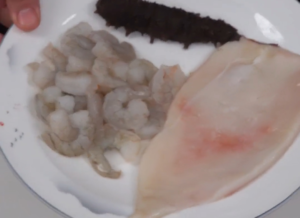
2.When handling the squid, we can use the technique of flower cutting to create squid flowers. Firstly, tilt the knife at a 45-degree angle and start cutting the squid from one side, cutting about 3/4 of it. Then, change the angle so that the knife edge is perpendicular to the previous cut, and once again tilt the knife at an angle, cutting another 3/4 part. Through this process, the squid will be cut into small pieces, which are visually appealing and easy to absorb flavors. When cutting the squid, it is important to pay attention to the sharpness of the knife and accuracy of the cuts. Cut swiftly and cleanly without hesitation. Also, be mindful of hand safety to avoid injuries.
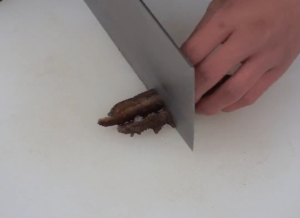
3.When handling the sea cucumber, we can split it in half from the middle. Then, gently scoop out the interior part of the body cavity with a knife, ensuring that any impurities inside the sea cucumber are removed. Next, we can proceed to cut the sea cucumber into strips. While cutting the sea cucumber, maintain a sharp knife and perform gentle and precise movements. Avoid applying excessive force to prevent damaging the shape and texture of the sea cucumber.
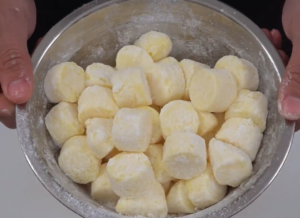
4.When handling the Japanese tofu, we first gently slice it open from the middle and remove the skin. Next, we cut the Japanese tofu into segments that are about two centimeters thick for easier handling. To make the Japanese tofu crispy, we need to add starch and shake it well to evenly coat each piece of tofu. In the process of adding starch, it’s best to do it in small amounts multiple times to ensure that each piece of Japanese tofu is uniformly coated. This avoids having too much or too little starch, resulting in a perfect texture.
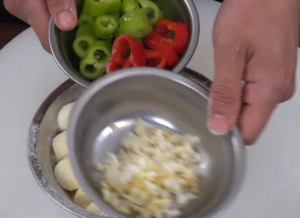
5.Finally, to enhance the aroma and color of the dish, we prepare some scallions, ginger, garlic, green peppers, and red peppers. We chop them into minced pieces or slice them into rings and set them aside on a plate. These ingredients will add rich flavors and textures to the Three Fresh Japanese tofu. Scallions and ginger can enhance the aroma, while garlic adds a spicy taste. Green and red peppers add color and a slightly spicy flavor, making the dish more appetizing.
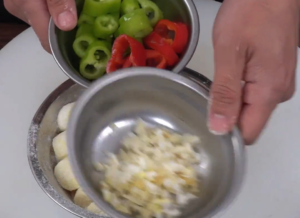
6.Boil water in a pot and blanch the prepared Three Fresh ingredients in it. During the blanching process, observe the changes in the ingredients in the pot. When the squid curls up and the shrimp turns red, you can pour out the water. Blanching is done to remove impurities and excess blood from the ingredients, while also making them refreshing and clean. Pay attention to the heat and timing during blanching to avoid overcooking or undercooking.
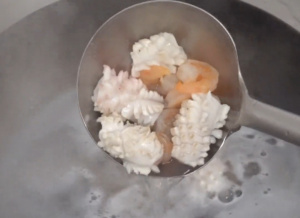
7.Heat oil in a pan until it reaches about 50% heat. Add the Japanese tofu and fry it for around 10-15 seconds until it becomes crispy and golden brown on the surface. Then, add the prepared ingredients to the pan after slightly stirring the oil. After a quick stir-fry in the pan, pour out the excess oil. The purpose of frying the Japanese tofu is to make it crispy and delicious while also removing some moisture for a richer texture. Avoid frying for too long to prevent the tofu from becoming overly charred and hard. When frying the ingredients, also control the heat and timing to ensure their texture and color. Removing excess oil helps prevent the dish from being too greasy and affecting the taste.
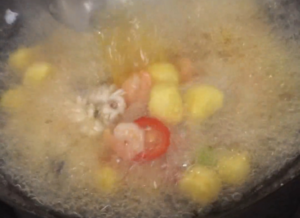
8.Leave a little oil in the pan, then add minced scallions, ginger, and garlic to sauté until fragrant. Then, add a little bit of oyster sauce and light soy sauce, followed by a small amount of water. Add an appropriate amount of salt and sugar based on your taste to enhance the flavors. Sprinkle some essence of chicken and add a small amount of water starch to thicken the sauce. Stir-fry all the ingredients quickly and evenly. Drizzle a little sesame oil along the sides of the pan and continue stir-frying for even distribution. This cooking process adds more flavor to the Three Fresh Japanese tofu, making it more delicious. Thickening the sauce helps coat the ingredients better and enhances the richness of the dish. Adding sesame oil contributes to the aroma and layers of flavor.
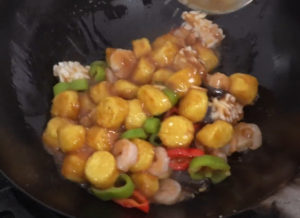
9.After thorough stir-frying, you can plate the Three Fresh Japanese tofu. Carefully transfer the cooked dish to the serving plate, presenting it with a perfect appearance and texture. A delicious and visually appealing Three Fresh Japanese tofu is now ready. This dish not only tastes great but also provides abundant nutritional value, making it a perfect choice for family gatherings or friend’s get-togethers. You can enjoy it with rice or noodles to enhance the texture. Additionally, you can add some chili or other seasonings according to your taste preferences to elevate the flavor and complexity of the dish. Overall, Three Fresh Japanese tofu is a popular Chinese cuisine that not only boasts vibrant colors but also has a rich and flavorful taste. If you haven’t tried it yet, why not give it a try? I believe you will fall in love with its deliciousness.
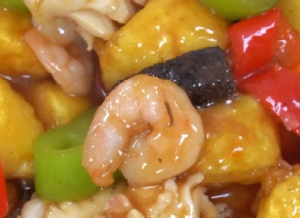
Tips:
1.Slice the Japanese tofu into thick pieces and coat them with starch before frying to enhance the texture and aroma.
2.It’s best to blanch the shrimp, sea cucumber, and squid to remove any fishy smell.
Three Fresh Japanese Tofu is like a beautiful symphony of flavors, with its rich texture, long history, and high nutritional value. It is a dish full of oriental flavors that has gained popularity among food lovers due to its unique taste and abundance of nutrients. Three Fresh Japanese Tofu mainly consists of silky and flavorful Japanese tofu, complemented by delicious ingredients such as shrimp. Every bite reveals the delicate texture of the tofu and the savory taste of the shrimp. This dish not only offers a diverse range of textures but also provides high nutritional value, including protein, calcium, iron, and other essential nutrients that are beneficial to our health.
